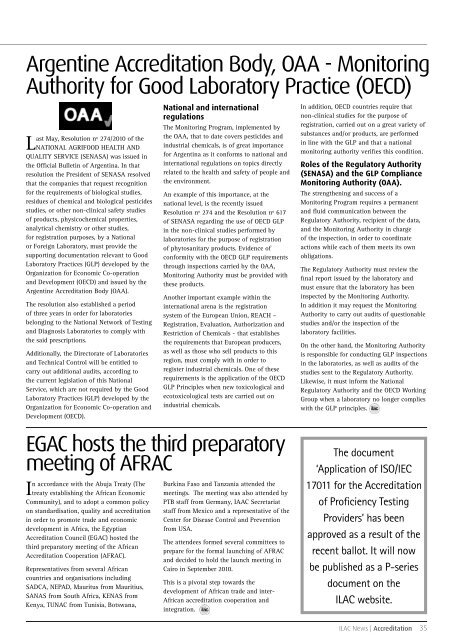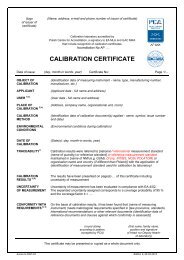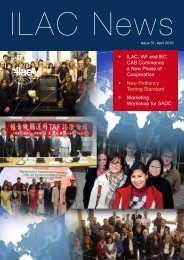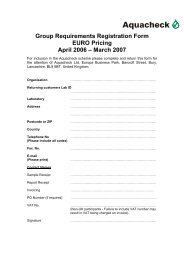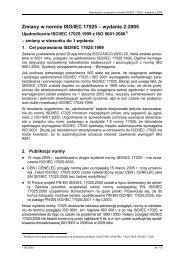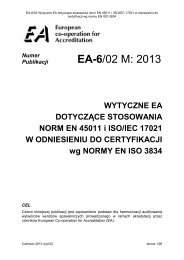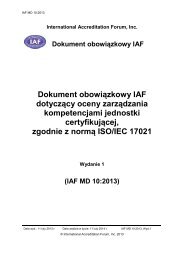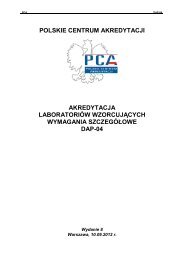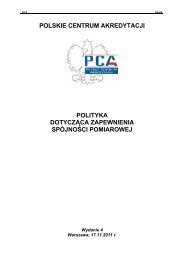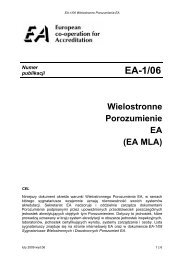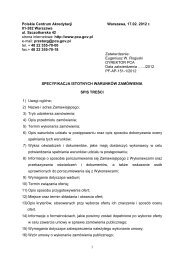ILAC News 38
ILAC News 38
ILAC News 38
- No tags were found...
Create successful ePaper yourself
Turn your PDF publications into a flip-book with our unique Google optimized e-Paper software.
Argentine Accreditation Body, OAA - MonitoringAuthority for Good Laboratory Practice (OECD)Last May, Resolution nº 274/2010 of theNATIONAL AGRIFOOD HEALTH ANDQUALITY SERVICE (SENASA) was issued inthe Official Bulletin of Argentina. In thatresolution the President of SENASA resolvedthat the companies that request recognitionfor the requirements of biological studies,residues of chemical and biological pesticidesstudies, or other non-clinical safety studiesof products, physicochemical properties,analytical chemistry or other studies,for registration purposes, by a Nationalor Foreign Laboratory, must provide thesupporting documentation relevant to GoodLaboratory Practices (GLP) developed by theOrganization for Economic Co-operationand Development (OECD) and issued by theArgentine Accreditation Body (OAA).The resolution also established a periodof three years in order for laboratoriesbelonging to the National Network of Testingand Diagnosis Laboratories to comply withthe said prescriptions.Additionally, the Directorate of Laboratoriesand Technical Control will be entitled tocarry out additional audits, according tothe current legislation of this NationalService, which are not required by the GoodLaboratory Practices (GLP) developed by theOrganization for Economic Co-operation andDevelopment (OECD).EGAC hosts the third preparatorymeeting of AFRACIn accordance with the Abuja Treaty (Thetreaty establishing the African EconomicCommunity), and to adopt a common policyon standardisation, quality and accreditationin order to promote trade and economicdevelopment in Africa, the EgyptianAccreditation Council (EGAC) hosted thethird preparatory meeting of the AfricanAccreditation Cooperation (AFRAC).Representatives from several Africancountries and organisations includingSADCA, NEPAD, Mauritus from Mauritius,SANAS from South Africa, KENAS fromKenya, TUNAC from Tunisia, Botswana,National and internationalregulationsThe Monitoring Program, implemented bythe OAA, that to date covers pesticides andindustrial chemicals, is of great importancefor Argentina as it conforms to national andinternational regulations on topics directlyrelated to the health and safety of people andthe environment.An example of this importance, at thenational level, is the recently issuedResolution nº 274 and the Resolution nº 617of SENASA regarding the use of OECD GLPin the non-clinical studies performed bylaboratories for the purpose of registrationof phytosanitary products. Evidence ofconformity with the OECD GLP requirementsthrough inspections carried by the OAA,Monitoring Authority must be provided withthese products.Another important example within theinternational arena is the registrationsystem of the European Union, REACH –Registration, Evaluation, Authorization andRestriction of Chemicals - that establishesthe requirements that European producers,as well as those who sell products to thisregion, must comply with in order toregister industrial chemicals. One of theserequirements is the application of the OECDGLP Principles when new toxicological andecotoxicological tests are carried out onindustrial chemicals.Burkina Faso and Tanzania attended themeetings. The meeting was also attended byPTB staff from Germany, IAAC Secretariatstaff from Mexico and a representative of theCenter for Disease Control and Preventionfrom USA.The attendees formed several committees toprepare for the formal launching of AFRACand decided to hold the launch meeting inCairo in September 2010.This is a pivotal step towards thedevelopment of African trade and inter-African accreditation cooperation andintegration.In addition, OECD countries require thatnon-clinical studies for the purpose ofregistration, carried out on a great variety ofsubstances and/or products, are performedin line with the GLP and that a nationalmonitoring authority verifies this condition.Roles of the Regulatory Authority(SENASA) and the GLP ComplianceMonitoring Authority (OAA).The strengthening and success of aMonitoring Program requires a permanentand fluid communication between theRegulatory Authority, recipient of the data,and the Monitoring Authority in chargeof the inspection, in order to coordinateactions while each of them meets its ownobligations.The Regulatory Authority must review thefinal report issued by the laboratory andmust ensure that the laboratory has beeninspected by the Monitoring Authority.In addition it may request the MonitoringAuthority to carry out audits of questionablestudies and/or the inspection of thelaboratory facilities.On the other hand, the Monitoring Authorityis responsible for conducting GLP inspectionsin the laboratories, as well as audits of thestudies sent to the Regulatory Authority.Likewise, it must inform the NationalRegulatory Authority and the OECD WorkingGroup when a laboratory no longer complieswith the GLP principles.The document‘Application of ISO/IEC17011 for the Accreditationof Proficiency TestingProviders’ has beenapproved as a result of therecent ballot. It will nowbe published as a P-seriesdocument on the<strong>ILAC</strong> website.<strong>ILAC</strong> <strong>News</strong> | Accreditation35


